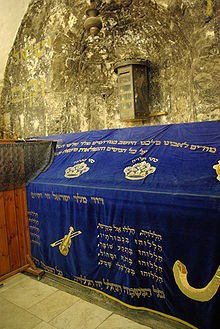- David's Tomb
-
King David's Tomb (Hebrew: קבר דוד המלך) is the name given to a Jewish religious site on Mount Zion in Jerusalem, near the Hagia Maria Sion Abbey; the site has traditionally been viewed as the burial place of King David, the second king of Israel. It is situated in a ground floor corner of the remains of the former Hagia Zion, a Byzantine church; the upper floor of the same building has traditionally been viewed as the Cenacle of Jesus. In 1335, the church became a Franciscan monastery, but, due to tensions with the Greek Orthodox Patriarch, the monastery was closed in 1551, and ownership of the site was transferred to a Muslim family. The building is now part of the Diaspora Yeshiva.
After the 1948 Arab–Israeli War, it fell on the Israel side of the Green Line. Between 1948 and 1967 the Old City was occupied by Jordan, which barred entry to Jews even for the purpose of praying at Jewish holy sites. The closest accessible site to the site of the ancient Jewish Temple was Mount Zion. Jewish pilgrims from around the country and the world went to David's Tomb and climbed to the rooftop to pray.[1]
The site was apparently not viewed as David's Tomb until the 12th century. According to Benjamin of Tudela, writing about 1173, the tomb was discovered during repairs to the church; the motivation for it being declared to be the tomb of David is uncertain. It is impossible to verify whether the tomb is original to the location, as crusaders[citation needed] removed the tomb from its earlier context, and placed within it a stone sarcophagus, newly built for the purpose; the sarcophagus now rests over a 14th century floor. Since 1949, a blue cloth, with basic modernist ornamentation, has been placed over the sarcophagus. The images on the cloth include several crown-shaped Rimmon placed over Torah scrolls, and a violin, and the cloth also features several pieces of text written in Hebrew. The contents of the sarcophagus have not yet been subjected to any scientific analysis, to determine their age, former appearance, or even whether there is actually still a corpse there.
The authenticity of the site has been challenged on several grounds. According to the Hebrew Bible, David was actually buried within the City of David together with his forefathers;[2] by contrast, the 4th century Pilgrim of Bordeaux reports that he discovered David to be buried in Bethlehem, in a vault that also contained the tombs of Ezekiel, Jesse, Solomon, Job, and Asaph, with those names carved into the tomb walls.[3] The genuine David's Tomb is unlikely to contain any furnishings of value; according to the first century writer Josephus, Herod the Great tried to loot the tomb of David, but discovered that someone else had already done so before him[4]
Archaeologists, doubting the Mount Zion location and favouring the biblical account, have since the early 20th century sought the actual tomb in the City of David area.[5] In 1913, Raymond Weill found eight elaborate tombs at the south of the City of David,[6] which archaeologists have subsequently interpreted as strong candidates for the burial locations of the former kings of the city;[7] Hershel Shanks, for example, argues that the most ornate of these (officially labelled T1) is precisely where one would expect to find the burial site mentioned in the Bible.[8] Among those who agree with the academic and archaeological assessment of the Mount Zion site, some[who?] believe it actually is the tomb of a later king, possibly Manasseh, who is described in the Hebrew Bible as being buried in the Garden of the King rather than in the City of David like his predecessors.
See also
Holy sites in Judaism Holiest sites Four Holy Cities Land Tombs of biblical figures David's Tomb • Joseph's Tomb • Tomb of the MatriarchsCoordinates: 31°46′17.9″N 35°13′44.45″E / 31.771639°N 35.2290139°E
References
- ^ Jerusalem Divided: The Armistice Regime, 1947-1967, Raphael Israeli, Routledge, 2002, p. 6
- ^ 1 Kings 2:9
- ^ Itinerarium Burdigalense 598:4-6
- ^ Josephus, Antiquities of the Jews, 16:7:1
- ^ Kathleen Kenyon, Archaeology in the Holy Land (1985), page 333
- ^ Kathleen Kenyon, Archaeology in the Holy Land (1985), page 333
- ^ Hershel Shanks, Biblical Archaeology Review, January/February 1995, page 64
- ^ Hershel Shanks, Biblical Archaeology Review, January/February 1995, page 64
Categories:- Torah places
- Jerusalem shrines
- David
- Mount Zion
- Tombs of biblical people
- Jewish pilgrimage sites
Wikimedia Foundation. 2010.

